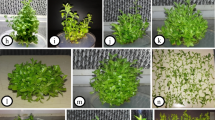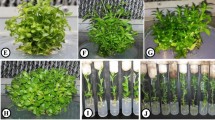Abstract
This study reports efficient protocols of tissue culture of Spirodela polyrhiza, the only species whose whole genome (including nuclear, mitochondrial and chloroplast genome) has been sequenced in Lemnaceae. The callus induction, callus maintenance and plant regeneration have been established. Sixteen kinds of combinations of phytohormones from the orthogonal combinations of four auxins and four cytokinins, and 64 kinds of orthogonal combinations of concentration for each combination of phytohormones were tested for callus induction. Callus were induced with a high efficiency from the root apical meristem on the MS medium with the phytohormone combination of 2,4-D and thidiazuron by a method called “Rhizoids-hovering”. Unlike other reported species in Lemnaceae whose callus has been induced from frond, frond of S. polyrhiza cannot be induced into callus under all tested conditions in this study. The stable callus line which is cultured on the medium of callus maintenance with reduced phytohormone under dark condition has been maintained healthy proliferation for more than three years. The callus of S. polyrhiza can be easily regenerated under a broad range of concentration of cytokinins.




Similar content being viewed by others
Abbreviations
- 2,4-D:
-
2,4-Dichlorophenoxyacetic acid
- NAA:
-
α-Naphthylacetic acid
- DCB:
-
Dicamba
- PCA:
-
p-Chlorophenoxy acetic acid
- TDZ:
-
Thidiazuron
- 6-BA:
-
6-Benzylaminopurine
- 2iP:
-
N6-(2-Isopentenyl) adenine
- KT:
-
Kinetin
- PVP:
-
Polyvinylpyrrolidone
References
Abhishek A, Karjagi CG, Nath R, Bhardwaj M, Ramteke PW, Kumar P, Dass S, Kumar RS (2014) Differential effect of immature embryo’s age and genotypes on embryogenic type II callus production and whole plant regeneration in tropical maize inbred lines (Zea mays L.). Indian J Genet Plant Breed 74:317–324
Al-Nozaily F, Alaerts G, Veenstra S (2000a) Performance of duckweed-covered sewage lagoons—I. Oxygen balance and cod removal. Water Res 34:2727–2733
Al-Nozaily F, Alaerts G, Veenstra S (2000b) Performance of duckweed-covered sewage lagoons—II. Nitrogen and phosphorus balance and plant productivity. Water Res 34:2734–2741
Armstrong CL, Romero-Severson J, Hodges TK (1992) Improved tissue culture response of an elite maize inbred through backcross breeding, and identification of chromosomal regions important for regeneration by RFLP analysis. Theor Appl Genet 84:755–762
Brain RA, Solomon KR (2007) A protocol for conducting 7-day daily renewal tests with Lemna gibba. Nat Protoc 2:979–987
Chaloupkova K, Smart CC (1994) The abscisic acid induction of a novel peroxidase is antagonized by cytokinin in Spirodela polyrrhiza L. Plant Physiol 105:497–507
Cox KM, Sterling JD, Regan JT, Gasdaska JR, Frantz KK, Peele CG, Black A, Passmore D, Moldovan-Loomis C, Srinivasan M, Cuison S, Cardarelli PM, Dickey LF (2006) Glycan optimization of a human monoclonal antibody in the aquatic plant Lemna minor. Nat Biotechnol 24:1591–1597
Goopy JP, Murray PJ (2003) A review on the role of duckweed in nutrient reclamation and as a source of animal feed. Asian Austral J Anim 16:297–305
Hillman WS (1966) Photoperiodism in Lemna: reversal of nightinterruption depends on color of the main photoperiod. Science 154:1360–1362
Hillman WS (1970) Carbon dioxide output as an index of circadian timing in Lemna photoperiodism. Plant Physiol 45:273–279
Hillman WS (1976) Calibrating duckweeds: light, clocks, metabolism, flowering. Science 193:453–458
Hoque ME, Mansfield JW (2004) Effect of genotype and explant age on callus induction and subsequent plant regeneration from root-derived callus of Indica rice genotypes. Plant Cell Tissue Org 78:217–223
Islam K (2002) Feasibility of duckweed as poultry feed—a review. India J Anim Sci 72:486–491
Kumar V, Sharma SS (1999) Nutrient deficiency-dependent anthocyanin development in Spirodela polyrhiza L. Schleid. Biol Plant 42:621–624
Les DH, Crawford DJ (1999) Landoltia (Lemnaceae), a new genus of duckweeds. NOVON 9:530–533
Les DH, Landolt E, Crawford DJ (1997) Systematics of the Lemnaceae (duckweeds): inferences from micromolecular and morphological data. Plant Syst Evol 204:161–177
Li J, Jain M, Vunsh R, Vishnevetsky J, Hanania U, Flaishman M, Perl A, Edelman M (2004) Callus induction and regeneration in Spirodela and Lemna. Plant Cell Rep 22:457–464
Liu QD, Zhu YR, Tao HL, Wang NN, Wang Y (2006) Damage of PSII during senescence of Spirodela polyrrhiza explants under long-day conditions and its prevention by 6-benzyladenine. J Plant Res 119:145–152
Ozengin N, Elmaci A (2007) Performance of Duckweed (Lemna minor L.) on different types of wastewater treatment. J Environ Biol 28:307–314
Rival S, Wisniewski J, Langlais A, Kaplan H, Freyssinet G, Vancanneyt G, Vunsh R, Perl A, Edelman M (2008) Spirodela (duckweed) as an alternative production system for pharmaceuticals: a case study, aprotinin. Transgenic Res 17:503–513
Rolfe SA, Tobin EM (1991) Deletion analysis of a phytochrome-regulated monocot rbcS promoter in a transient assay system. Proc Natl Acad Sci USA 88:2683–2686
Scherr C, Simon M, Spranger J, Baumgartner S (2008) Test system stability and natural variability of a Lemna gibba L. bioassay. PLoS ONE 3:e3133
Sree KS, Bog M, Appenroth KJ (2016) Taxonomy of duckweeds (Lemnaceae), potential new crop plants. Emir J Food Agr 28:291–302
Stomp AM (2005) The duckweeds: a valuable plant for biomanufacturing. Biotechnol Annu Rev 11:69–99
Tao X, Fang Y, Xiao Y, Jin Y, Ma X, Zhao Y, He K, Zhao H, Wang H (2013) Comparative transcriptome analysis to investigate the high starch accumulation of duckweed (Landoltia punctata) under nutrient starvation. Biotechnol Biofuels 6:72
Vunsh R, Li J, Hanania U, Edelman M, Flaishman M, Perl A, Wisniewski J, Freyssinet G (2007) High expression of transgene protein in Spirodela. Plant Cell Rep 26:1511–1519
Wang YR (2016) Callus induction and frond regeneration in Spirodela polyrhiza. Czech J Genet Plant Breed 52:114–119
Wang WQ, Kerstetter RA, Michael TP (2011) Evolution of genome size in duckweeds (Lemnaceae). J Bot 1:9
Wang W, Wu Y, Messing J (2012) The mitochondrial genome of an aquatic plant, Spirodela polyrhiza. PLOS ONE 7:e4674710
Wang W, Haberer G, Gundlach H, Glaesser C, Nussbaumer T, Luo MC, Lomsadze A, Borodovsky M, Kerstetter RA, Shanklin J, Byrant DW, Mockler TC, Appenroth KJ, Grimwood J, Jenkins J, Chow J, Choi C, Adam C, Cao XH, Fuchs J, Schubert I, Rokhsar D, Schmutz J, Michael TP, Mayer KFX, Messing J (2014) The Spirodela polyrhiza genome reveals insights into its neotenous reduction fast growth and aquatic lifestyle. Nat Commun 5:1–14
Xu J, Cui W, Cheng JJ, Stomp A (2011) Production of high-starch duckweed and its conversion to bioethanol. Biosyst Eng 110:67–72
Yamamoto YT, Rajbhandari N, Lin XH, Bergmann BA, Nishimura Y, Stomp AM (2001) Genetic transformation of duckweed Lemna gibba and Lemna minor. In Vitro Cell Dev Biol 37:349–353
Yin Y, Yu C, Yu L, Zhao J, Sun C, Ma Y, Zhou G (2015) The influence of light intensity and photoperiod on duckweed biomass and starch accumulation for bioethanol production. Bioresour Technol 187:84–90
Zhu YR, Tao HL, Lv XY, Wang SF, Wang NN, Wang Y (2004) High level of endogenous L-serine initiates senescence in Spirodela polyrrhiza. Plant Sci 166:1159–1166
Zhu YR, Lu XY, Wang SF, Wang NN, Wang Y (2005) The relationship between photorespiration and senescence of S. polyrrhiza P143. Plant Sci 168:1625–1632
Acknowledgements
This work was supported by the Science and Technology project of Guangdong Province (No. 2016A010105020) and the Doctoral Initiation Foundation of Guangdong University of Technology (No. 253141005).
Author information
Authors and Affiliations
Contributions
MXH performed most of the experiments, analyzed data, and drafted the manuscript. XYM and YSZ helped perform some experiments of tissue culture. QXH, MHF and YLH helped analyze data, draft, and revise the manuscript. All authors reviewed the results and approved the final version of the manuscript.
Corresponding author
Ethics declarations
Conflict of interest
The authors declare that they have no competing interests.
Additional information
Communicated by Qiao-Chun Wang.
Electronic supplementary material
Below is the link to the electronic supplementary material.
Rights and permissions
About this article
Cite this article
Huang, M., Ma, X., Zhong, Y. et al. Callus induction and plant regeneration of Spirodela polyrhiza. Plant Cell Tiss Organ Cult 135, 445–453 (2018). https://doi.org/10.1007/s11240-018-1477-7
Received:
Accepted:
Published:
Issue Date:
DOI: https://doi.org/10.1007/s11240-018-1477-7




